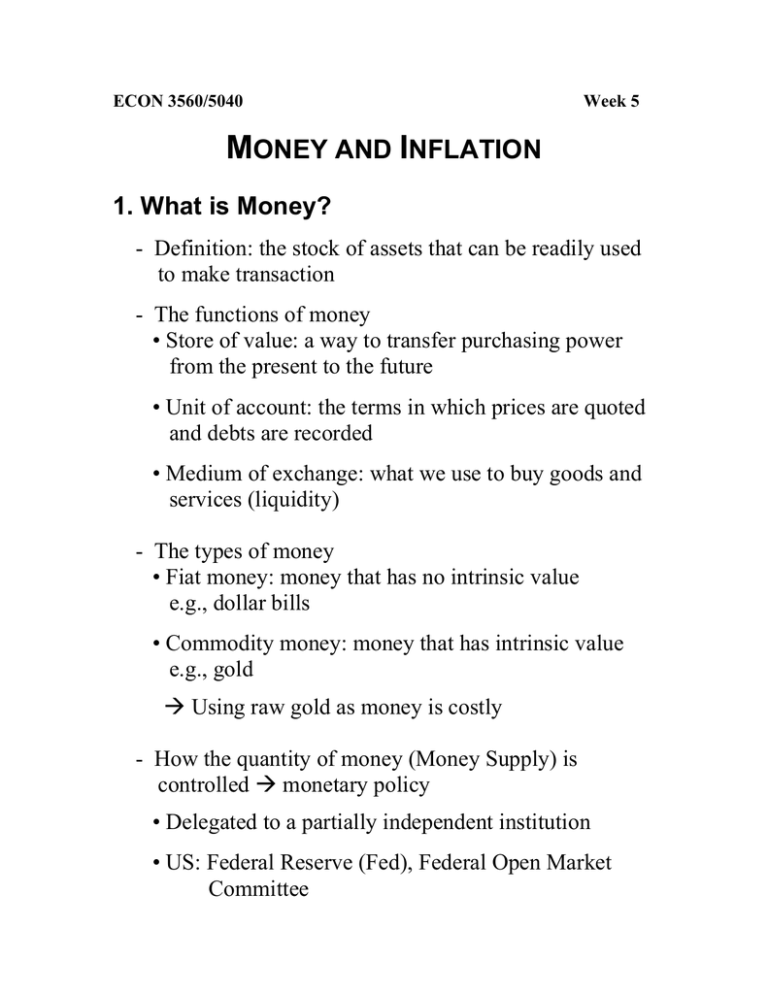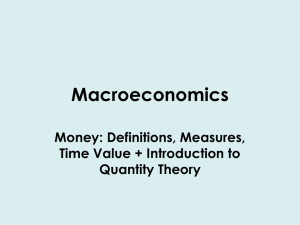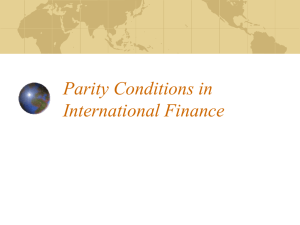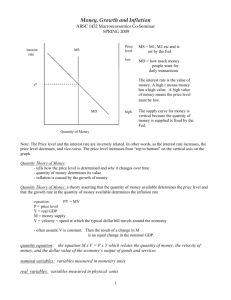M I ONEY AND
advertisement

ECON 3560/5040 Week 5 MONEY AND INFLATION 1. What is Money? - Definition: the stock of assets that can be readily used to make transaction - The functions of money • Store of value: a way to transfer purchasing power from the present to the future • Unit of account: the terms in which prices are quoted and debts are recorded • Medium of exchange: what we use to buy goods and services (liquidity) - The types of money • Fiat money: money that has no intrinsic value e.g., dollar bills • Commodity money: money that has intrinsic value e.g., gold Æ Using raw gold as money is costly - How the quantity of money (Money Supply) is controlled Æ monetary policy • Delegated to a partially independent institution • US: Federal Reserve (Fed), Federal Open Market Committee • Open market operation: the purchase and sale of government bonds e.g., buy bonds from the public Æ MS ↑ - How the quantity of money is measured (table 4-1, p.81) 2. The Quantity Theory of Money Æ How the quantity of money affects the economy - Transactions and the quantity equation • Quantity equation: the link b/t transactions and money Æ M ×V = P × T 1) M : the quantity of money 2) V : the transaction velocity of money (measures the rate at which money circulates in the economy) 3) P : the price of a typical transaction (the number of dollars exchanged) 4) T : total number of transactions during some period of time Æ difficult to measure Æ M ×V = P × Y , Y : Total output of the economy (real GDP) P : GDP deflator V : Income velocity of money - Money demand function Æ What determines the quantity of real money balance ( M / P ) people wish to hold Æ M / P = kY Æ M (1 / k ) = PY Æ If V = 1 / k , M × V = P × Y • The link b/t the demand for money and the velocity e.g., When people want to hold a lot of money for each dollar of income, money changes hands infrequently - The quantity theory of Money Assuming constant velocity, M × V = P × Y . Æ A change in the quantity of money must cause a proportionate change in nominal GDP Æ i.e., If velocity is fixed, the quantity of money determines the dollar value of the economy’s output - Money, Price, and Inflation (fig. 4-1 – 4-2) 1) The factor of production & the production function ÆY 2) Money supply Æ the (nominal) value of output( PY ) 3) P is determined Æ The price level is proportional to the money supply % change in M + % change in V = % change in P + % change in Y cf) “Inflation is always and everywhere a monetary phenomenon” (Milton Friedman) 3. Inflation and Interest Rates - Nominal interest rate vs. Real interest rate • Nominal interest rate( i ): the rate of interest that investors pay to borrow money • Real interest rate( r ): the nominal interest rate corrected for the effects of inflation Ær=i–π - The Fisher Effect • Fisher equation: i = r + π Æ Nominal interest rate can change b/c 1) real interest rate changes 2) inflation rate changes • The Fisher effect: one-for-one relationship b/t the inflation rate and nominal interest rate (fig. 4-3 & 4-4, pp. 90-91) i.e., an increase in the rate of money growth of 1% Æ 1% increase in the rate of inflation Æ 1% increase in the nominal interest rate 4. Nominal Interest Rate and the Demand for Money - The nominal interest rate is the opportunity cost of holding money - The quantity of money demanded depends both on the level of income and on the nominal interest rate. Æ ( M / P ) D = L( i , Y ) = L( r + π , Y ) - The linkage among money, price, and interest rates (fig. 4-5, p.94) 5. The Social Costs of Inflation (1) The costs of “expected” inflation - The distortion of the inflation tax on the amount of money people hold - Menu costs: firms change their posted price very often - Variability in relative prices Æ microeconomic inefficiency - The distortion of individuals’ tax liability - Inconvenience of living in a world with a changing price level (2) The costs of “unexpected” inflation - Arbitrarily redistributes wealth among individuals - Hurt individuals on fixed pensions - Uncertainty 6. Hyperinflation - Inflation that exceeds 50 percent per month. Æ more than 100-fold increase in price level over a year - The costs of hyperinflation - The causes of hyperinflation • Excessive growth in the supply of money - Hyperinflation in interwar Germany (fig.4-6, p.106)








